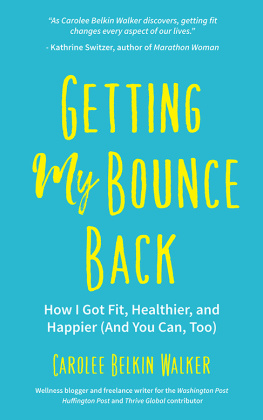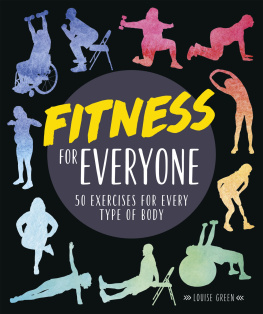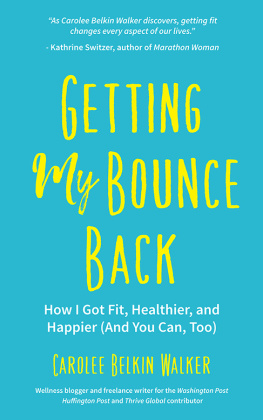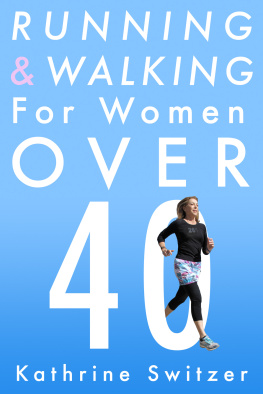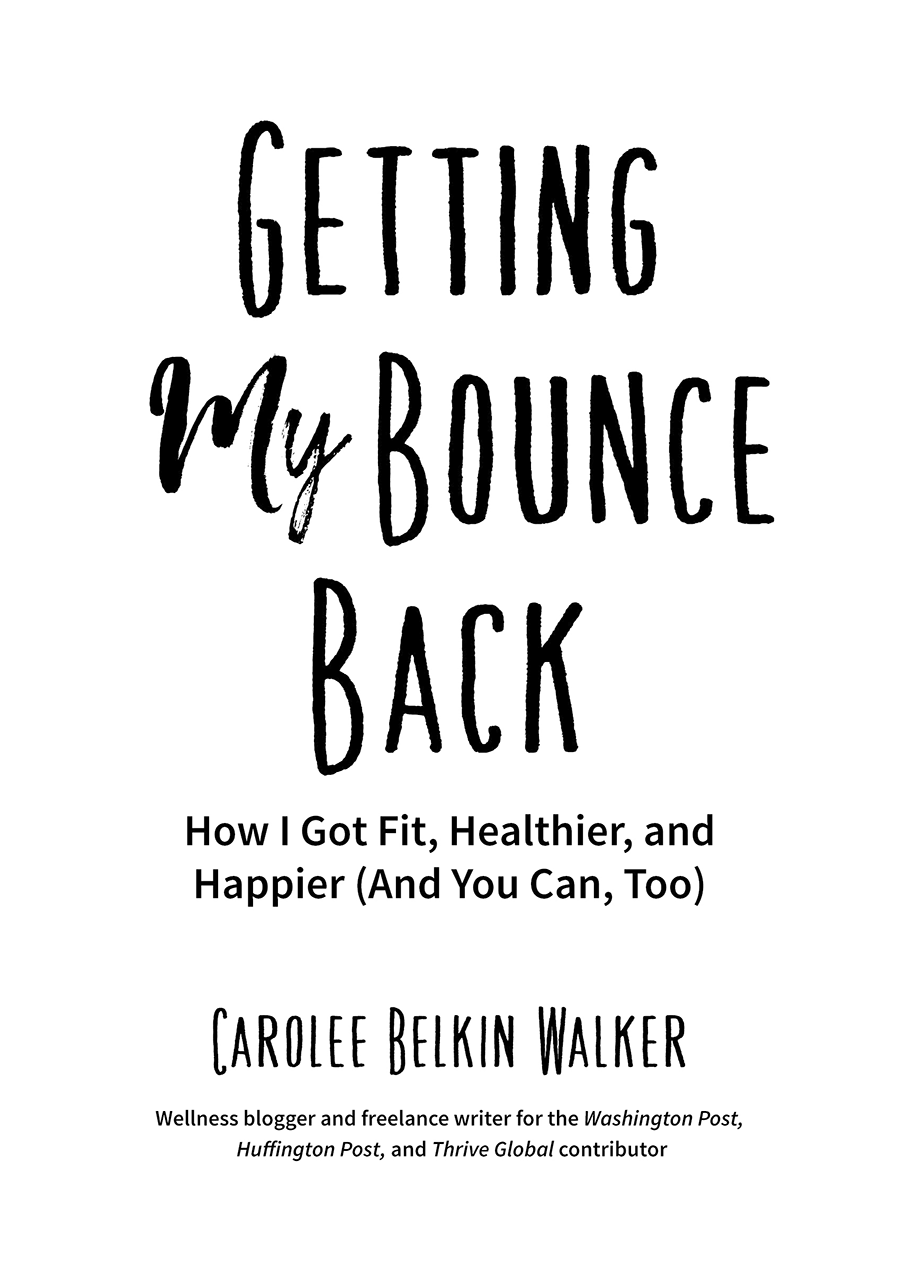
Copyright 2018 Carolee Belkin Walker.
Published by Mango Publishing Group, a division of Mango Media Inc.
Cover and Layout Design: Elina Diaz
Mango is an active supporter of authors rights to free speech and artistic expression in their books. The purpose of copyright is to encourage authors to produce exceptional works that enrich our culture and our open society.
Uploading or distributing photos, scans or any content from this book without prior permission is theft of the authors intellectual property. Please honor the authors work as you would your own. Thank you in advance for respecting our authors rights.
For permission requests, please contact the publisher at:
Mango Publishing Group
2850 Douglas Road, 3rd Floor
Coral Gables, FL 33134 USA
For special orders, quantity sales, course adoptions and corporate sales, please email the publisher at or +1.800.509.4887.
Getting My Bounce Back: How I Got Fit, Healthier, and Happier (And You Can, Too)
Library of Congress Cataloging
ISBN: (print) 978-1-63353-710-1 (ebook) 978-1-63353-711-8
Library of Congress Control Number: 2017964328
BISAC category code: BISAC category code HEA010000 HEALTH & FITNESS / Healthy Living BISAC category code HEA024000 HEALTH & FITNESS / Womens Health
Printed in the United States of America
The author of this book does not dispense medical advice or prescribe the use of any of the techniques in this book as a form of treatment for physical, mental, or emotional problems without the advice of a trained health professional. The information contained herein should be considered as being of a general nature to help you in your quest to lose weight and for emotional well-being, good health, and spiritual growth. Each individuals situation and needs are different. The author and publisher specifically disclaim any liability, loss, or risk, personal or otherwise, which is incurred as a consequence, directly or indirectly, of the use and application of any of the contents of this book. In addition, the opinions, views, and suggestions expressed in this book are entirely those of the author.
For my family, I love you all.
Praise
Exercise and fitness support our life. It makes us strongphysically, emotionally, and psychologically. It keeps our
heart pumping. It promises that we will be able to keep at our
lifes work longer than if we did not move and that we will someday take our childrens childrens children swimming in the ocean when we are 98. It is a joyful experience and we get to do it. How lucky are we to be able to support our life like this?
As Carolee would say: You got this.
Sarajean Rudman, from the Foreword
Carolee Walkers Getting My Bounce Back is an engaging and inspiring read. Getting fit and training to compete in endurance events is no walk in the park, even for the hardiest among us. There are few books out there that genuinely describe the ups and downs of reinventing yourself at midlife while simultaneously teaching us how we can all do it. In this memoir, Carolees authentic voice shines through as she describes her personal journey of self-discovery and personal mastery. Carolees journey is instructive, funny, relatable, and most of all, inspiring.
Chris Friesen, PhD, sport & performance neuropsychologist and author of the High Achievement Handbook series
Getting my bounce back are the words every runner needs to hear. Often we are shown images and words that portray an easy connection between starting a fitness journey and reaching the moment where everything is easy (although as an elite runner,
I know that it never truly becomes easy, you just get tougher).
Most books and publications just show the end result, as if we magically appear at the peak of fitness and ideal look, but Carolee allows us to peek into her inner mind, showing us that there is a journey behind those photos, and a point where a health journey switches over from the lose weight mentality to realizing the joy and light exercise brings us in more valuable and meaningful ways. For anyone who has ever wondered why everyone else made it
seem so easy, this book is for you.
Tina Muir, elite runner and host of the
Running for Real podcast
Contents
Within the philosophy of action theory, there are two prerequisites that can lead to action: desire and belief. If we are hungry and desire to be full, and we believe a sandwich will satisfy that desire, we will eat the sandwich. But are these truly the prerequisites to committed action? What about the case for daily exercise: we desire to be at a certain level of physical fitness, and we believe that daily exercise will lead us to that level of physical fitness. According to action theory, we should all exercise daily. So why is it that so many people do not act, day after day? Why is it sometimes easy to exercise and sometimes not? What makes us commit? There must be more. Something bigger than us. Something that can lead to committed action.
Yes, there is. And it is different for everyone.
It is true that we can commit to exercising before work, or join a fitness club with a goal of going to classes daily, or set our sights on a running goal. We might even achieve those goals, to some extent, and for some amount of time. More than likely, however, once the goal is met, or once we grow bored of trying, we will stop doing what we are doing and go back to simply desiring a more fit life that we believe can be achieved through fitness goals, but with the bizarre inability to propel ourselves into action. The key word being: ourselves .
When asked what really lights you up, you probably do not answer: Myself. Humans, in general, come equipped with a certain set of values. These are values that they have collected over time and grown into, often passed down to them from their foremothers and forefathers. It is building a house of commitment upon the concrete foundation of ones values that creates the ability to take action: chronic action, habitual action, life-changing action, committed action. If we build the house of commitment upon a foundation of should or need or ourselves, we might as well have built it upon a pile of sand. We will inevitably tire of ourselves or break the rules weve made for ourselves. A house built on sand will crumble the moment action comes blowing in the wind. Brick by brick, stone by stone, we will be left with nothing but a pile of our own unsatisfied desires, charred by the subtle fire of what we once believed to be the solution, no longer willing or able to act on those beliefs for fear of being burned again.
Burned by ourselves.
This is bigger than ourselves .
Start by figuring out what in this life is most important to you. Maybe it is family, nature, or loyalty. Maybe it is being creative, fun-loving, adventure-seeking, or community-driven. Perhaps it is humor, spirituality, or being a helper or a teacher. Whatever it is, this is where you must lay the foundation for your house of committed action. This is where your non-negotiable fitness habit becomes part of your blueprint, ingrained in your DNA, nestled in your soul.
The way you approach exercise is a choice. You can either begin your fitness routine thinking, I have to do this, or, as I prefer, I get to do this. When you get to work out, run, hike, swim, or whatever gets your heart pounding and body moving, you come from a place of gratitude and purpose. When you have to work out, you come from a place of fear, grasping, and obligation. Not that obligation is always a terrible thing, but it is important to remain clear about what it is that we are obligated to. Being obligated to feed and clothe your child is very different from feeling obligated to run for two hours every day, or to go to barre or spinning every day for a month, or even to hit a goal in a race if you are not really feeling it. Feeding and clothing your child is a real obligation, something you must do to live in alignment with your values. If you have children, you probably hold family as a very high value and work for your familys safety and welfare. Therefore, you will be committed to act: feeding your child is a committed action because it is driven by a value.
Next page
